Characterization of Performance of Short Stroke Engines with Valve Timing for Blended Bioethanol Internal Combustion
Abstract
:1. Introduction
- To theoretically define the proper intake and exhaust valve timing. The original engine performance is also calculated as the baseline.
- To compare the calculated results with the measured data for the purpose of verification.
- To identify the effect of the Atkinson cycle on the brake specific fuel consumption (BSFC) power output, torque, and emissions for short stroke engines.
- To experimentally analyze engine performance with the proper intake and outtake valve timing, and to delineate the BSFC, power output, torque, and emissions for different ethanol blended fuels.
2. Methodology
3. Results and Discussion
3.1. Setting of Valve Timing
3.2. Effect of the Expansion to Compression Ratio
3.3. Bioethanol Application
3.4. Discussion
4. Conclusions
- With appropriate intake and exhaust valve settings, fuel consumption and engine performance can be well adjusted. However, better engine performance results in higher NO emissions. Due to the innate properties of short stroke engine, only a few operation ranges can be adjusted.
- Short stroke engines cannot achieve high Atkinson cycle efficiency due to lower compression pressure, which induces a lower flame propagation speed and heat loss through the surfaces of the piston and cylinder head in the combustion chamber.
- From the experimental and numerical results, we see that as the engine ECR value increases to achieve an Atkinson cycle, the engine torque, power rate, and NO emissions will all decrease, and the amount of CO and HC will increase for short stroke engines due to increased I-EGR.
- It is necessary to vary the ignition time for fuel containing higher ethanol composition to overcome the lower flame propagation speed induced by the lower heating value of the fuel. A higher composition of ethanol in the blended fuel induces lower engine performance and higher emissions of CO and HC, while NO emissions are reduced.
Author Contributions
Acknowledgments
Conflicts of Interest
References
- Statistics Inquiry, Ministry of Transportation and Communications, Taiwan. Available online: http://stat.motc.gov.tw (accessed on 20 June 2016).
- Atkinson, J. Gas Engine. U.S. Patent 367496A.
- Heywood, J. Internal Combustion Engine Fundamentals; McGraw-Hill: New York, NY, USA, 1997. [Google Scholar]
- Ferrey, P.; Miehe, Y.; Constensou, C.; Collee, V. Potential of a variable compression ratio gasoline SI engine with very high expansion ratio and variable valve actuation. SAE Int. J. Engines 2014, 7, 468–487. [Google Scholar] [CrossRef]
- Chen, L.; Lin, J.; Sun, F.; Wu, C. Efficiency of an Atkinson engine at maximum power density. Energy Convers. Manag. 1998, 39, 337–341. [Google Scholar] [CrossRef]
- Wang, P.Y.; Hou, S.S. Performance analysis and comparison of an Atkinson cycle coupled to variable temperature heat reservoirs under maximum power and maximum power density conditions. Energy Convers. Manag. 2005, 46, 2637–2655. [Google Scholar] [CrossRef]
- Hou, S.S. Comparison of performances of air standard Atkinson and Otto cycles with heat transfer considerations. Energy Convers. Manag. 2007, 48, 1683–1690. [Google Scholar] [CrossRef]
- Boretti, A.; Scalzo, J. Novel Crankshaft Mechanism and Regenerative Braking System to Improve the Fuel Economy of Light Duty Vehicles and Passenger Cars. SAE Int. J. Passeng. Cars—Mech. Syst. 2012, 5, 1177–1193. [Google Scholar] [CrossRef]
- Benajes, J.; Serrano, J.R.; Molina, S.; Novella, R. Potential of Atkinson cycle combined with EGR for pollutant control in a HD diesel engine. Energy Convers. Manag. 2009, 50, 174–183. [Google Scholar] [CrossRef]
- Čuček, L.; Varbanov, P.S.; Klemeš, J.J.; Kravanja, Z. A review of footprint analysis tools for monitoring impacts on sustainability. Energy 2012, 44, 135–145. [Google Scholar] [CrossRef]
- Mussatto, S.I.; Dragone, G.; Guimarães, P.M.; Silva, J.P.; Carneiro, L.M.; Roberto, I.C. Technological trends, global market, and challenges of bio-ethanol production. Biotechnol. Adv. 2010, 28, 817–830. [Google Scholar] [CrossRef] [PubMed] [Green Version]
- Kumar, S.; Singh, N.; Prasad, R. Anhydrous ethanol: A renewable source of energy. Renew. Sustain. Energy Rev. 2010, 14, 1830–1844. [Google Scholar] [CrossRef]
- Niven, R.K. Ethanol in gasoline: Environmental impacts and sustainability review article. Renew. Sustain. Energy Rev. 2005, 9, 535–555. [Google Scholar] [CrossRef]
- Agarwal, A.K. Biofuels (alcohols and biodiesel) applications as fuels for internal combustion engines. Prog. Energy Combust. Sci. 2007, 33, 233–271. [Google Scholar] [CrossRef]
- Stein, R.A.; Anderson, J.E.; Wallington, T.J. An overview of the effects of ethanol-gasoline blends on SI engine performance, fuel efficiency, and emissions. SAE Intern. Engines 2013, 6, 470–487. [Google Scholar] [CrossRef]
- Thangavelu, S.K.; Ahmed, A.S.; Ani, F.N. Review on bioethanol as alternative fuel for spark ignition engines. Renew. Sustain. Energy Rev. 2016, 56, 820–835. [Google Scholar] [CrossRef] [Green Version]
- Thompson, P.B. The agricultural ethics of biofuels: The food vs. fuel debate. Agriculture 2012, 2, 339–358. [Google Scholar] [CrossRef]
- Chen, W.H.; Tu, Y.J.; Sheen, H.K. Impact of dilute acid pretreatment on the structure of bagasse for producing bioethanol. Int. J. Energy Res. 2010, 34, 265–274. [Google Scholar] [CrossRef]
- Chen, W.H.; Tu, Y.J.; Sheen, H.K. Disruption of sugarcane bagasse lignocellulosic structure by means of dilute sulfuric acid with microwave-assisted heating. Appl. Energy 2011, 88, 2726–2734. [Google Scholar] [CrossRef]
- Limayem, A.; Ricke, S.C. Lignocellulosic biomass for bioethanol production: Current perspectives, potential issues and future prospects. Prog. Energy Combust. Sci. 2012, 38, 449–467. [Google Scholar] [CrossRef]
- Kun-Balog, A.; Sztankó, K.; Józa, V. Pollutant emission of gaseous and liquid aqueous bioethanol combustion in swirl burners. Energy Convers. Manag. 2017, 149, 896–903. [Google Scholar] [CrossRef]
- ANSI/ASME, Part 10, Flue and Exhaust Gas Analyses; Performance Test Code PTC 19.10; American Society of Mechanical Engineers: New York, NY, USA, 1981.
- Gamma Technologies. Available online: https://www.gtisoft.com/ (accessed on 20 June 2016).
- Constensou, C.; Collee, V. VCR-VVA-High Expansion Ratio, a Very Effective Way to Miller-Atkinson Cycle. In Proceedings of the SAE 2016 World Congress and Exhibition, Detroit, MI, USA, 12–14 April 2016. [Google Scholar]
- Andrews, G.E.; Bradley, D. The burning velocity of methan-air mixtures. Combust. Flame 1972, 19, 275–288. [Google Scholar] [CrossRef]
- Bayraktar, H. Experimental and theoretical investigation of using gasoline-ethanol blends in spark-ignition engines. Renew. Energy 2005, 30, 1733–1747. [Google Scholar] [CrossRef]
- Brunt, M.F.J.; Platts, K.C. Calculation of Heat Release in Direct Injection Diesel Engine. J. Engines 1999, 108, 161–175. [Google Scholar] [CrossRef]
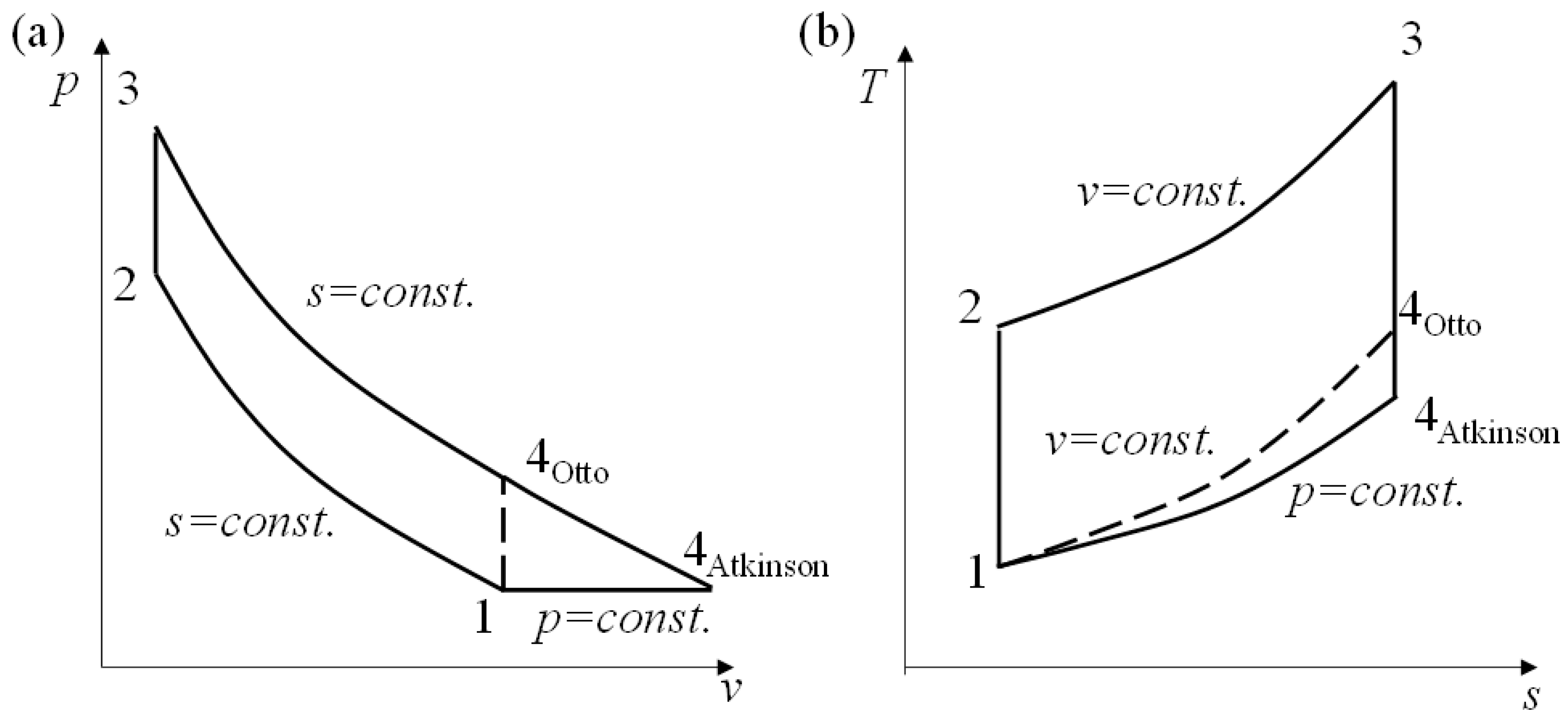


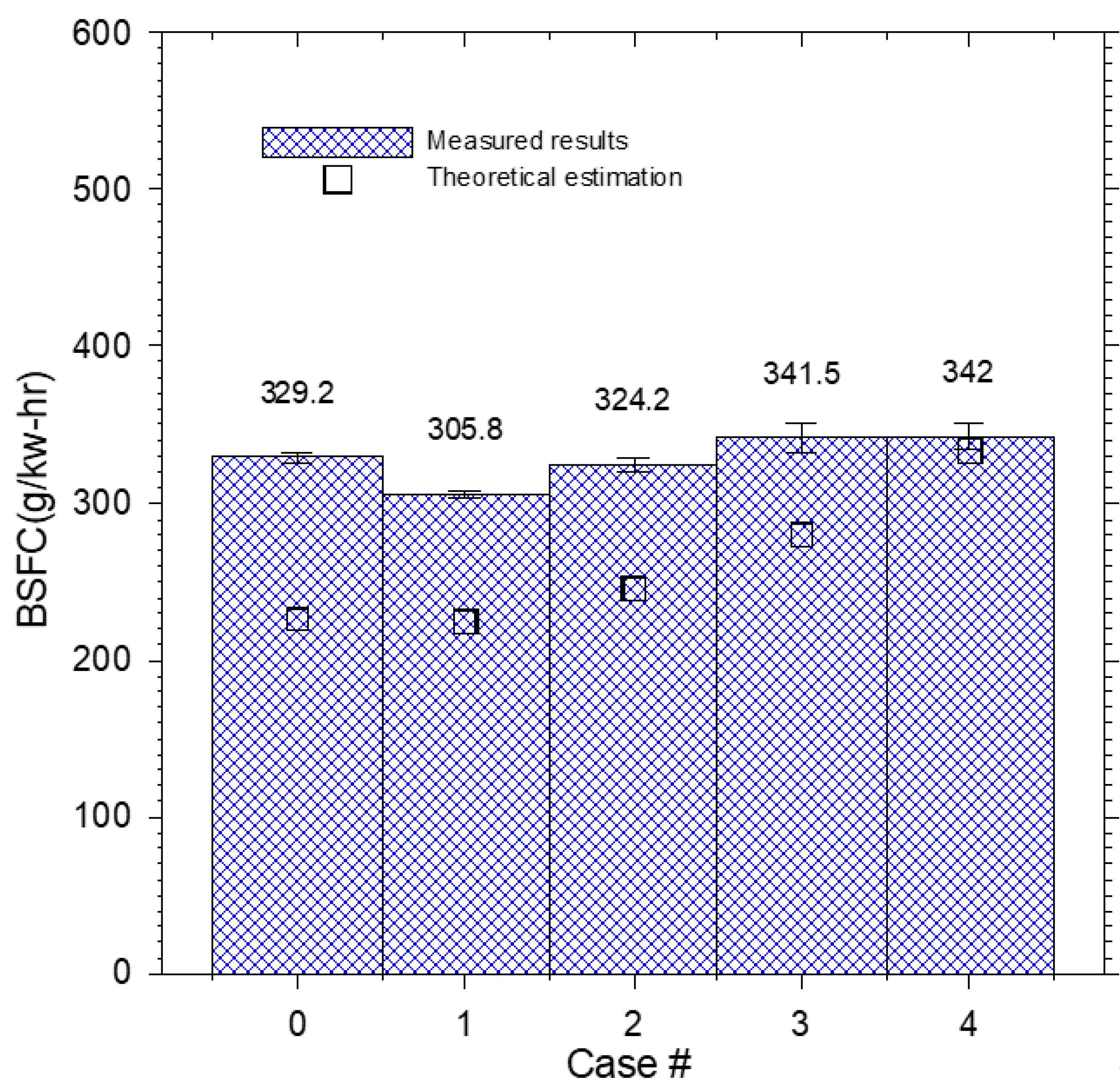
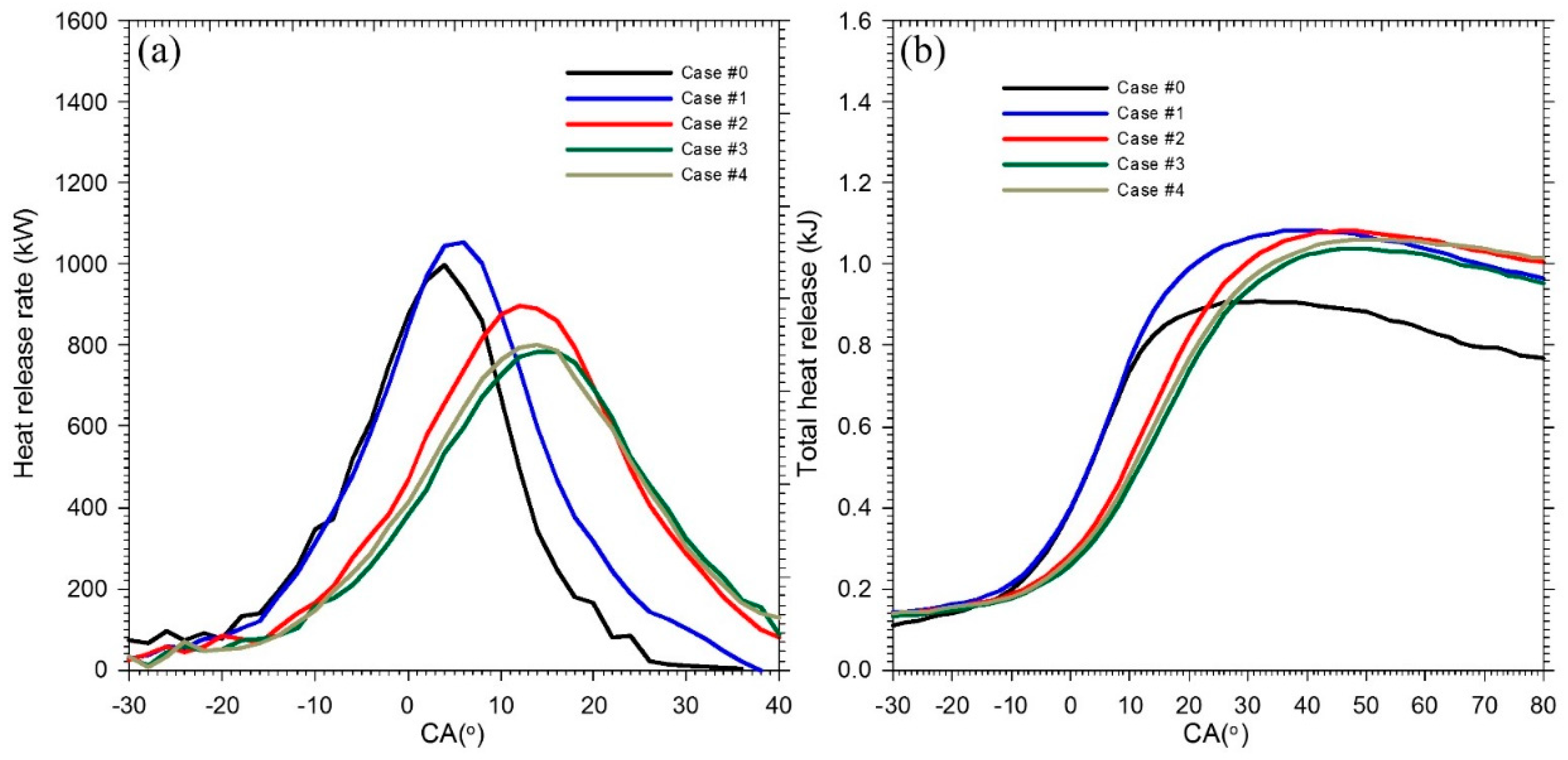
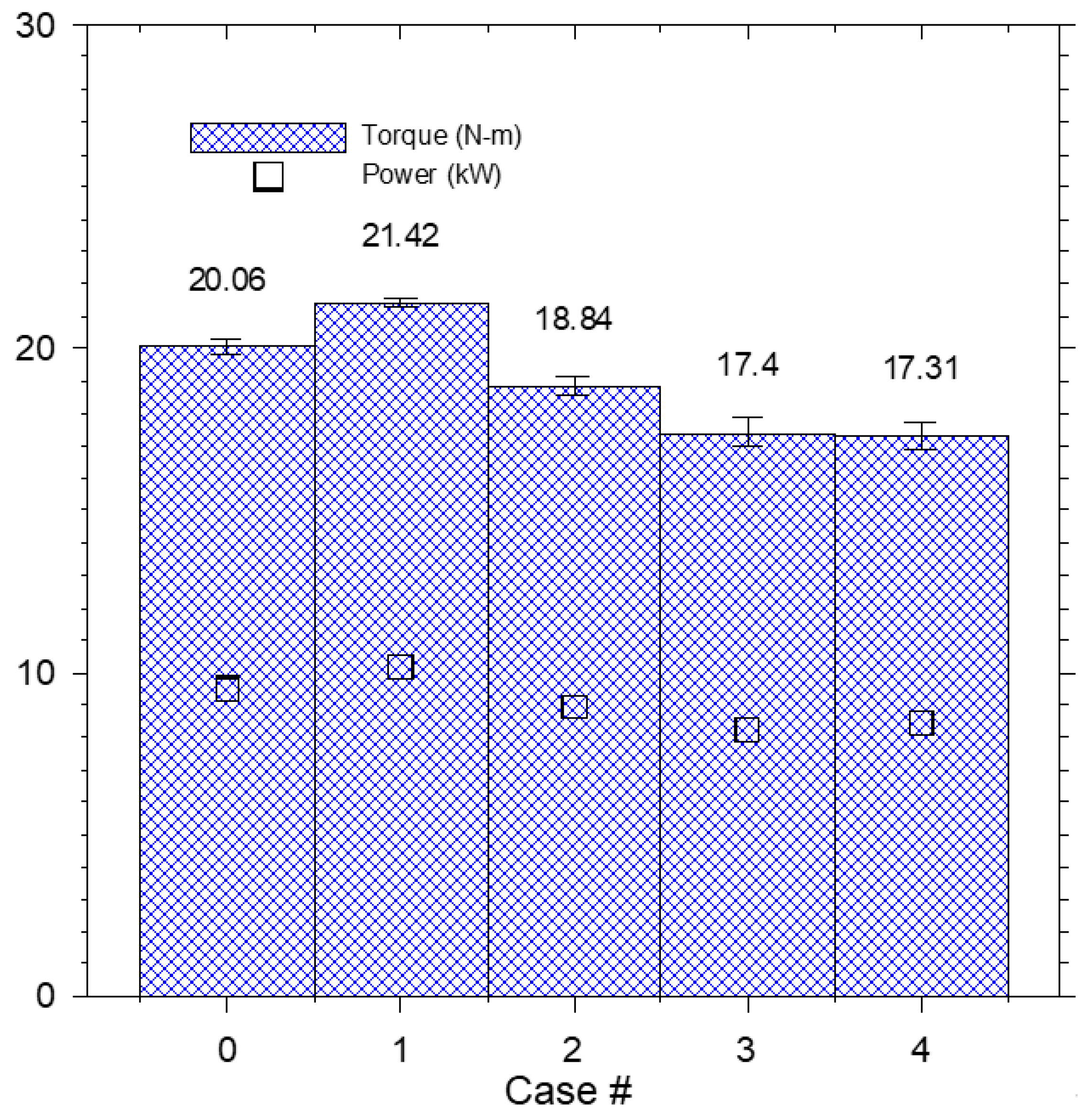
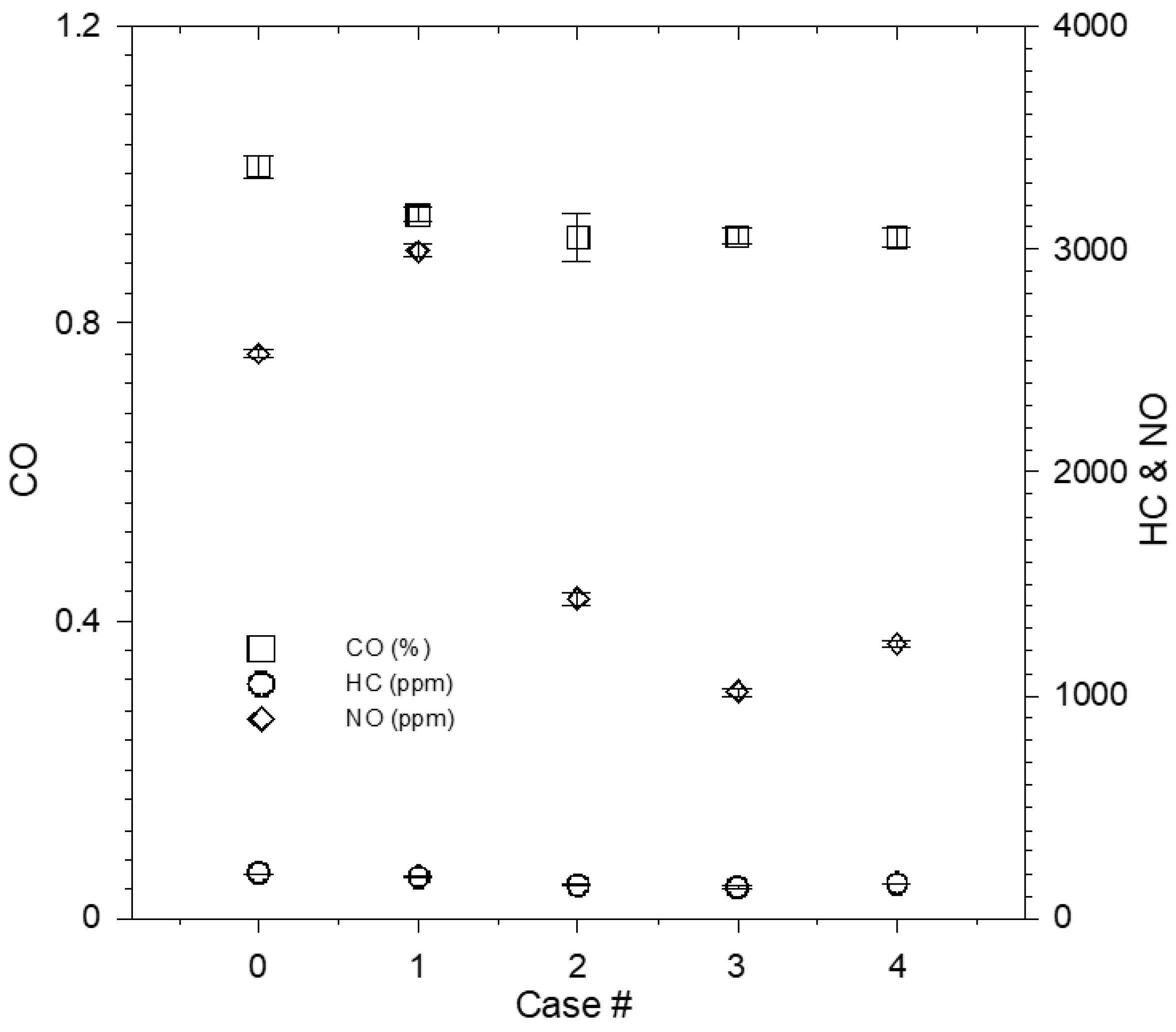
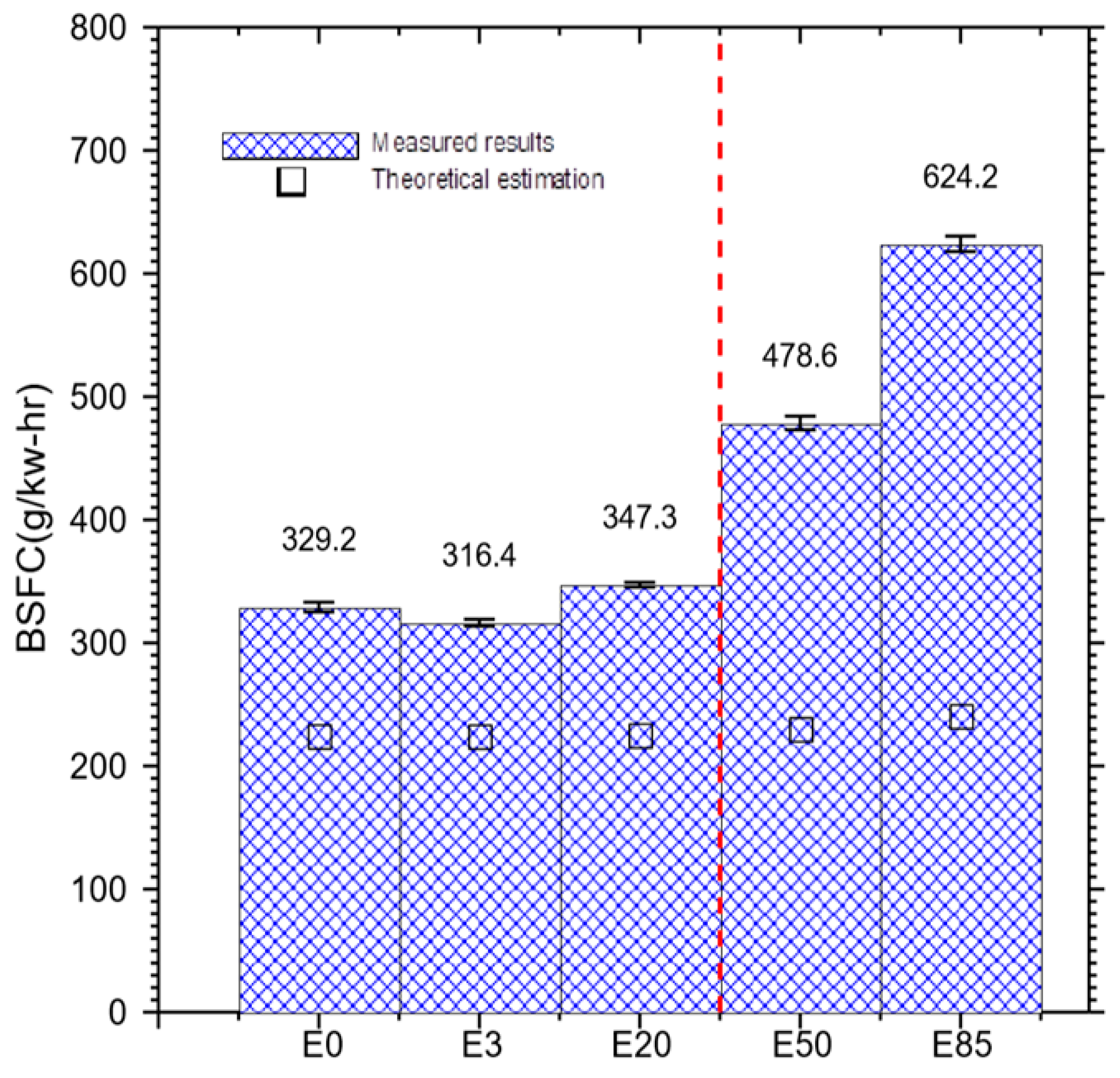
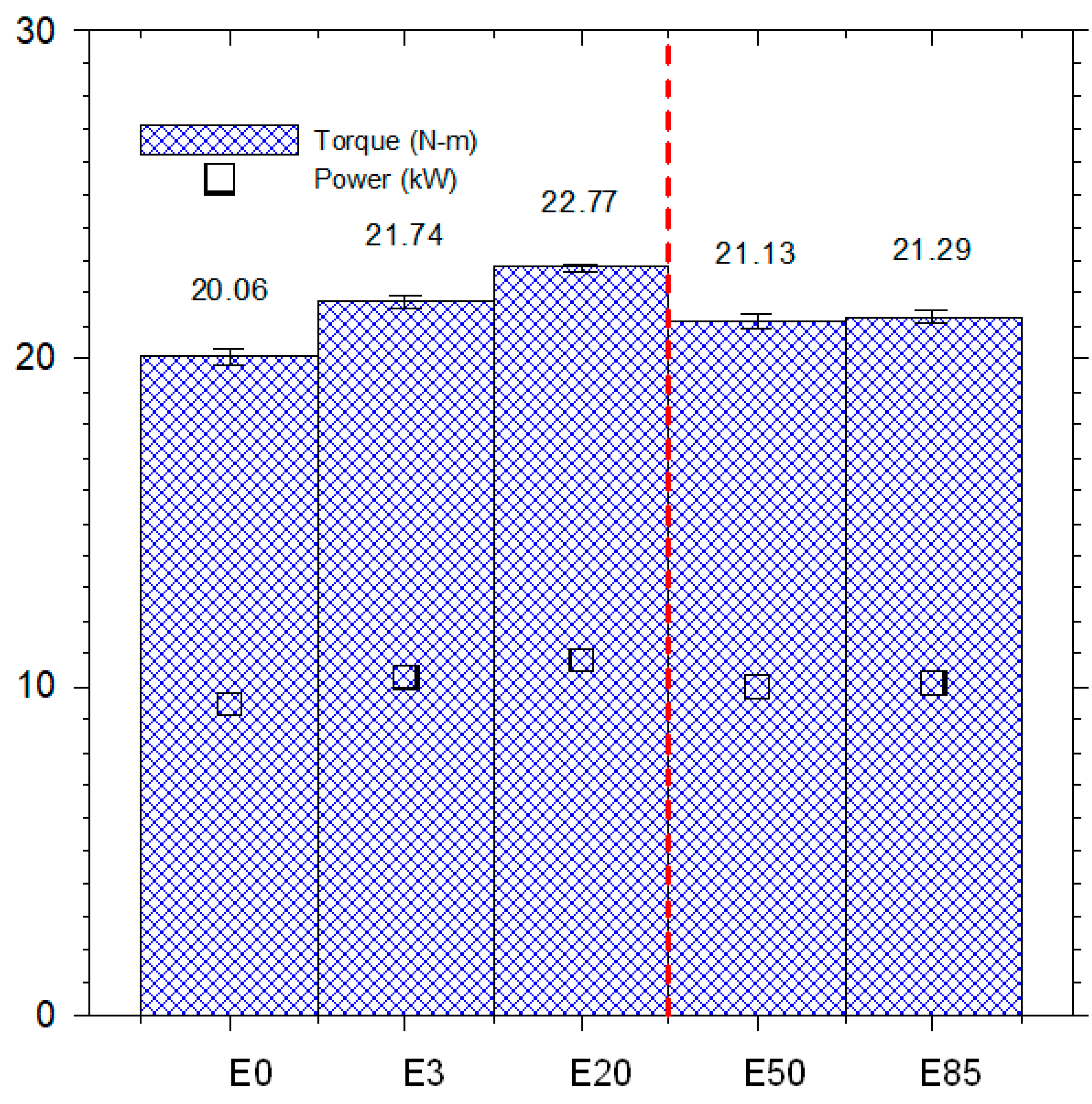
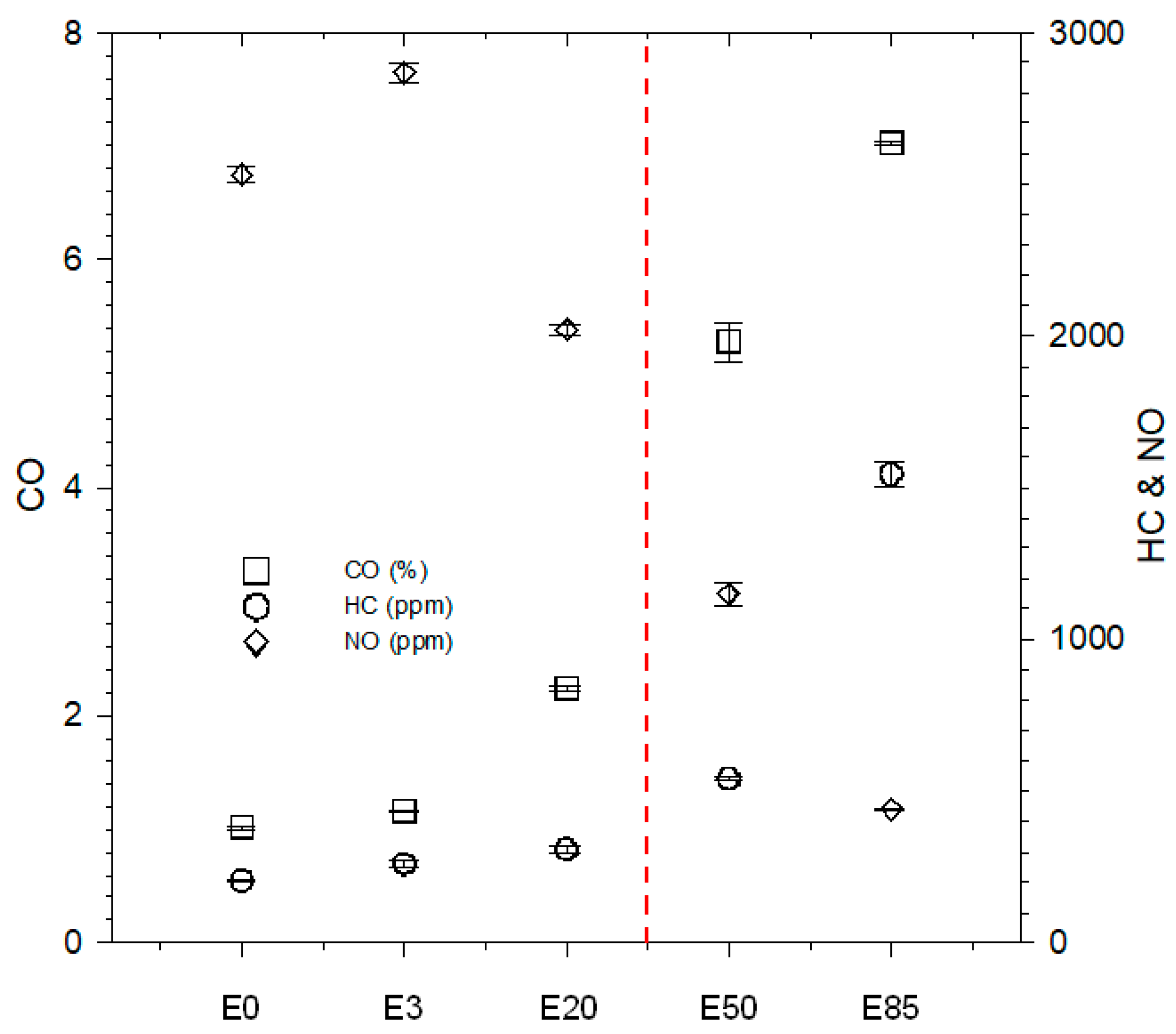
| Design | Specification |
|---|---|
| Engine type | Spark ignition engine |
| Cooling | Liquid cooled |
| no. of cylinders | 1 |
| Configuration | Port fuel injection |
| Bore | 92 mm |
| Stroke | 75 mm |
| Compression ratio | 10.6:1 |
| displacement | 498.5 cc |
| Cylinder head | 4 valve, DOHC |
| Apparatus | Model | range | uncertainty |
|---|---|---|---|
| MEXA-584l (gas analyzer) | Co | 0% to 10% vol | ±0.01% |
| HC | 0 to 20,000 ppm | ±3.3 ppm | |
| CO2 | 0% to 20% vol | ±0.17% | |
| NO | 0 to 5000 ppm | ±0.5 ppm | |
| O2 | 0% to 25% | ±0.5% | |
| Teledyne (air mass flow meter) | HFM-200 LFE | 0 to 200 LPM | ±0.5% |
| Siemens FC (fuel mass flow meter) | MASSFLO 4100 | 0 to 30 kg/h | ±0.1% |
| Optrand (pressure tranducer) | D322D6-SO | 0 to 200 bar | ±1% |
| Bosch LSU (AFR sensor) | 7200 | 9 to 41 | ±2% |
| Fuel | Z | W(cm/s) | η | ξ | α | β |
|---|---|---|---|---|---|---|
| C8H18 | 1 | 46.58 | −0.326 | 4.48 | 1.56 | −0.22 |
| C2H5OH | 1 | 46.5 | 0.25 | 6.34 | 1.75 | |
| C8H18 + C2H5OH | 1 + | 46.58 | −0.326 | 4.48 | 1.56 + 0.23 |
| Engine speed (rpm) | 4500 |
|---|---|
| Ambient pressure (Bar) | 1 |
| Ambient temperature (K) | 298 |
| Exhaust initial pressure (Bar) | 1 |
| Exhaust initial temp. (K) | 1120 |
| Exhaust initial wall temp. (K) | 1000 |
| Intake pressure (Bar) | 1 |
| Intake temp. (K) | 300.15 |
| Lamda (λ) | 1.0 |
| Intake cam lift (cm) | 0.83 |
| Exhaust cam lift (cm) | 0.82 |
| Case # | Intake Valve Open | Intake Valve Close | Exhaust Valve Open | Exhaust Valve Close | Valve Overlap | Expansion/Compression |
|---|---|---|---|---|---|---|
| 0 | 314 | −146 | 86 | −324 | 82 | 0.59 |
| 1 | 331 | −128 | 92 | −318 | 72 | 0.72 |
| 2 | 336 | −124 | 120 | −290 | 94 | 0.97 |
| 3 | 336 | −124 | 140 | −270 | 114 | 1.13 |
| 4 | 336 | −124 | 150 | −260 | 124 | 1.21 |
| unit: degree | ||||||
© 2019 by the authors. Licensee MDPI, Basel, Switzerland. This article is an open access article distributed under the terms and conditions of the Creative Commons Attribution (CC BY) license (http://creativecommons.org/licenses/by/4.0/).
Share and Cite
Chen, K.-H.; Chao, Y.-C. Characterization of Performance of Short Stroke Engines with Valve Timing for Blended Bioethanol Internal Combustion. Energies 2019, 12, 759. https://doi.org/10.3390/en12040759
Chen K-H, Chao Y-C. Characterization of Performance of Short Stroke Engines with Valve Timing for Blended Bioethanol Internal Combustion. Energies. 2019; 12(4):759. https://doi.org/10.3390/en12040759
Chicago/Turabian StyleChen, Kun-Ho, and Yei-Chin Chao. 2019. "Characterization of Performance of Short Stroke Engines with Valve Timing for Blended Bioethanol Internal Combustion" Energies 12, no. 4: 759. https://doi.org/10.3390/en12040759
APA StyleChen, K.-H., & Chao, Y.-C. (2019). Characterization of Performance of Short Stroke Engines with Valve Timing for Blended Bioethanol Internal Combustion. Energies, 12(4), 759. https://doi.org/10.3390/en12040759




